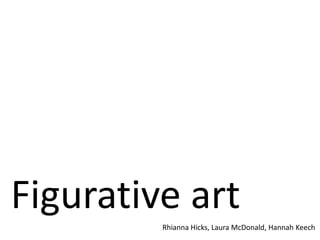Figurative Art
- 1. Figurative art Rhianna Hicks, Laura McDonald, Hannah Keech
- 2. Tansy Lee Moir Novar figure beech 1 Crichton torso beech 1 Hopetoun half-tree 7 Novar beech in soft light Rhianna
- 4. Michael Landy Shepherd's Purse Annual Wall Rocket Creeping Buttercup Rhianna
- 5. Rhianna
- 6. Sophie Calle ? Sophie Calles Series called Suite VĻĶnitienne (1980-96) follows her pursuit of an unsuspecting man that she followed through Venice. The way in which she includes herself in the work as the hunter in pursuit is both surreal and intense almost as you can feel her behind the camera. Her work is a really interesting look into identity and peoples possessions which say a lot about who they are. Throughout the images you can see she actively stalks the man but she goes even further into invading peopleĄŊs privacy in the photos that she took when serving as a maid in a Venetian hotel of peoples possessions in their hotel rooms. However, in an interview with The Independent she talks in responds to the invasiveness of her art work "In my work I do things that I would never do in my life. In normal life I am much more discreet. I am not intrusive. I don't investigate my friends' lives. But if it's a project then it's different,Ąą (Duguid, 2009). This project seems to highlight questions of how what we have and do says about us. Also it shows just how much information you can get about someone just by watching. Laura
- 7. Arne Svenson ? New York City Artist Arne Svenson recently came under fire for his series of photographs The Neighbours in which he photographed the glass building across from him. In the photographs you canĄŊt quite tell what the subjects are doing, giving the ordinariness of everyday life a new sense of mystery and ambiguity. "For my subjects there is no question of privacy; they are performing behind a transparent scrim on a stage of their own creation with the curtain raised high. The Neighbours don't know they are being photographed; I carefully shoot from the shadows of my home into theirs."(Weeks, J. 2013)People have questioned whether this is an invasion of privacy, to the extent two neighbours tried to sue but the court ruled it under the First AmendmentĄŊs guarantee of free speech. In none of the photos did Svenson Show the subjectĄŊs faces so it could be argued that as there not identifiable their privacy hadnĄŊt been breached. ItĄŊs hard to balance the idea of artistic licence between the privacy of the subjects which has been an issue for most artists. Laura
- 8. Figurative art can also be seen within video art Hannah








